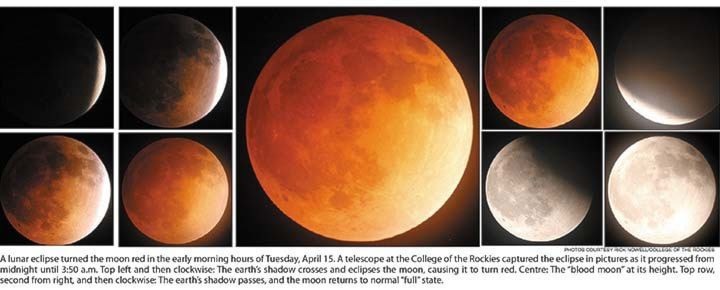Cranbrook was treated to a spectacular sky show overnight between Monday, April 14 and Tuesday, April 15 when a "blood moon" graced the spring sky.
The moon turned red for about one hour and 18 minutes during the full lunar eclipse, when the moon, Earth and sun were completely lined up. The reflection of the sun on Earth cast a red-orange glow on the moon as it was shielded from the sun's direct light.
Rick Nowell, an astronomer at the College of the Rockies in Cranbrook, captured the eclipse using the college's telescope, the Celestron Schmidt-Cassegrain, with an 11-inch primary mirror.
"It's meant for higher magnifications, so I had to attach a focal reducer to just barely fit all the moon in the picture," said Nowell.
In Cranbrook, the eclipse began at about 11 p.m. when the full moon was still visible to the south. Mars was closest to Earth on Monday also, so it was very bright in the sky nearby, Nowell said.
"The moon moved slowly easterly in the sky, and entered the Earth's shadow at midnight. The black part of the shadow cut a curved line into the moon's edge and gradually crept along for an hour, until the last bright edge narrowed and went dark at 1 a.m.," said Nowell.
"Unfortunately, a thin haze to the south started to cover the moon, and a lot of the photos became fuzzy after this. The dim orangey moon faded in and out behind clouds, but the camera was able to compensate somewhat."
While Earth was completely obscuring the sun, the sunlight passing through the Earth's atmosphere made the moon glow a reddish orange, Nowell went on.
"It took about three hours for the moon to move through the Earth's shadow. In the photos you can see that the moon was not evenly illuminated, since its orbit was a bit north of (above) the shadow cone."
The moon came out of the shadows at about 2:30 a.m., Nowell said, and it was back to a normal full moon at about 3:50 a.m.
"If you missed this one, the next lunar eclipse is on October 8, 2014," he added.
"This year we get to see a solar eclipse too: There will be a partial solar eclipse in Cranbrook on October 23 at 3:45 p.m."
